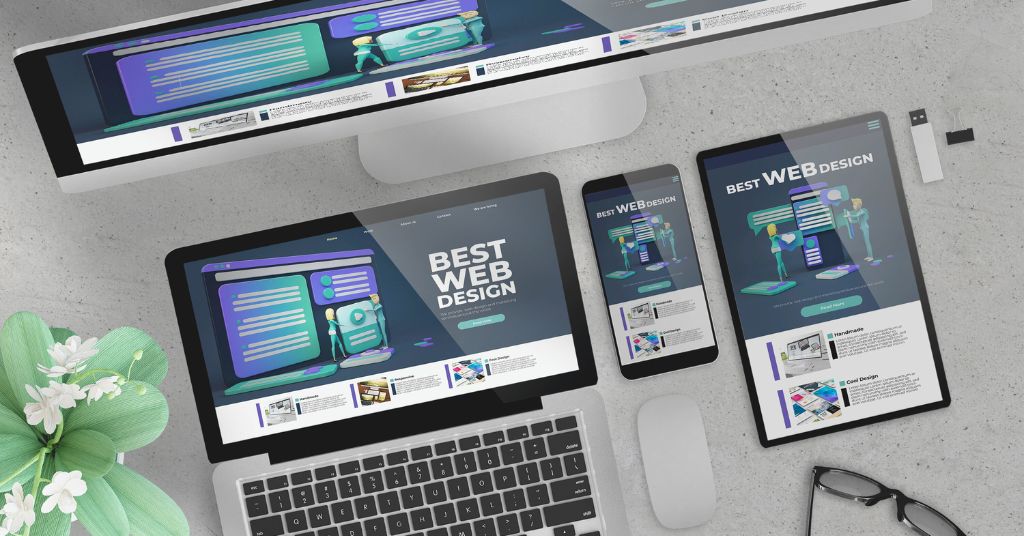When you’re looking to establish a high-performing online store, the importance of effective ecommerce web design can’t be overstated. It’s not just about aesthetics; it’s about creating an intuitive user experience that drives sales. Key features like mobile responsiveness and seamless navigation play a crucial role in keeping customers engaged. But what really sets apart the best Top eCommerce web design services? Understanding the nuances of custom versus template designs can significantly impact your store’s success. Let’s explore which elements can truly elevate your ecommerce platform to the next level.
Importance of Ecommerce Web Design
Ecommerce web design isn’t just about aesthetics; it’s a crucial element that can make or break your online business. When you’re looking to build a successful online store, you’ll quickly realize that the design you choose directly impacts user experience and conversion rates.
If your site is cluttered or difficult to navigate, potential customers will likely abandon their shopping carts and turn to competitors. That’s where the top ecommerce web design services come into play.
These services offer tailored solutions that focus on usability, ensuring that visitors can easily find what they’re looking for. They help you create a seamless shopping experience, which is vital for keeping customers engaged and encouraging them to make purchases.
Using the top ecommerce web design services for a high-performing online store means you’ll have access to professional expertise that helps you build a site that’s not only visually appealing but also functional.
With the right design, you’ll enhance your brand’s credibility, drive more traffic, and ultimately see an increase in sales. So, invest in quality web design; it’s a decision that pays off in the long run.
Key Features of Effective Design
When crafting an effective online store design, there are several key features to prioritize that can significantly enhance user experience.
First, focus on a clean and intuitive layout. A well-organized design helps customers navigate your site effortlessly, making it easier for them to find what they need.
Next, prioritize mobile responsiveness. With more shoppers using their phones, ensuring your site looks great and functions seamlessly on mobile devices is crucial.
Don’t forget about fast loading times; slow websites can lead to high bounce rates, so optimize images and streamline code to keep users engaged.
Another essential feature is high-quality visuals. Use crisp product images and engaging videos to showcase your offerings, as they can drive conversions.
Additionally, clear calls-to-action guide users through their shopping journey, so make sure they’re prominent and persuasive.
Lastly, integrate user-friendly search and filtering options. This allows customers to quickly locate products that meet their needs, improving their overall shopping experience.
Top Ecommerce Platforms Reviewed
Choosing the right platform can make or break your online store’s success, so it’s essential to weigh your options carefully. Several top ecommerce platforms stand out in 2023, each catering to different needs and preferences.
Shopify is a favorite for its user-friendly interface and extensive app ecosystem. You’ll find everything from payment processors to marketing tools, making it a solid choice for beginners and seasoned sellers alike.
WooCommerce, on the other hand, integrates seamlessly with WordPress, offering flexibility and customization for those comfortable with tech.
BigCommerce is another strong contender, especially for scaling businesses. It offers built-in features that reduce reliance on third-party apps, which can save you time and money.
If you’re looking for a more niche platform, consider Squarespace. While primarily a website builder, it provides stunning design options and is great for creatives.
Lastly, Magento offers robust features for larger enterprises requiring complex customizations. However, it may be overwhelming for smaller businesses.
Evaluate your specific needs, budget, and technical expertise to find the best fit for your online store. Making the right choice now can lead to long-term success.
Custom vs. Template Designs
Weighing the options between custom and template designs is crucial for your online store’s identity. Custom designs offer a unique look tailored specifically to your brand, helping you stand out in a crowded market. When you go custom, you can incorporate your vision, colors, and features that align with your business goals. This approach can enhance user experience but often requires a higher budget and longer development time.
On the other hand, template designs provide a quicker, more cost-effective solution. With numerous pre-built options available, you can launch your store faster without sacrificing quality. Templates are often user-friendly, allowing you to make modifications easily as your business grows. However, they can limit your uniqueness, as many other stores might use the same design.
Ultimately, the choice depends on your brand’s needs and budget. If you’re looking for a distinctive presence and have the resources, a custom design might be worth the investment. If you’re just starting or need a budget-friendly option, templates can serve you well while still offering flexibility for future changes.
Evaluate your priorities carefully to make the best decision for your online store.
Mobile Responsiveness in Design
As mobile usage continues to rise, ensuring your ecommerce site is mobile-responsive is essential for reaching a broader audience. A mobile-responsive design adapts seamlessly to various screen sizes, providing users with an optimal viewing experience on smartphones and tablets. This flexibility not only enhances usability but also boosts your site’s search engine ranking, as Google prioritizes mobile-friendly sites.
To achieve mobile responsiveness, start with a fluid layout that adjusts elements based on the user’s device. Use scalable images that maintain quality without compromising load speed. Additionally, consider touch-friendly navigation, making it easy for users to click buttons and links without hassle.
Testing your site on multiple devices is crucial. You want to ensure that everything functions correctly across different platforms, as bugs can frustrate potential customers. Employing tools like Google’s Mobile-Friendly Test can help identify issues that need fixing.
Lastly, keep in mind that a mobile-responsive design can significantly increase conversion rates. When customers can easily browse and shop on their devices, they’re more likely to complete purchases.
Prioritizing mobile responsiveness isn’t just a trend; it’s a necessity for your ecommerce success.
User Experience Best Practices
User experience (UX) is the cornerstone of any successful ecommerce website. To create a seamless shopping experience, you need to focus on several best practices.
First, prioritize intuitive navigation. Ensure your menus are clear, enabling customers to find products easily. Use categories and filters effectively to streamline their search.
Next, optimize your site speed. A slow-loading page can frustrate users, causing them to leave before making a purchase. Aim for load times under three seconds to keep customers engaged.
Additionally, use high-quality images and detailed product descriptions to showcase items. This helps customers make informed decisions and reduces the likelihood of returns.
Don’t underestimate the importance of a mobile-friendly design. Many users shop on their phones, so ensure that your site looks great and functions well on smaller screens.
Implement a simple checkout process to reduce cart abandonment. The fewer steps customers have to take, the better their experience will be.
Lastly, gather feedback through surveys or user testing. Listening to your customers’ insights can reveal pain points and areas for improvement, allowing you to continually enhance the user experience on your ecommerce site.
SEO Considerations for Ecommerce
When it comes to ecommerce, effective SEO can significantly impact your visibility and sales. To enhance your online store’s performance, start by conducting thorough keyword research. Identify terms your potential customers are searching for and incorporate these strategically into your product descriptions, titles, and meta tags.
Next, focus on optimizing your site structure. A well-organized site not only improves user experience but also helps search engines crawl your pages more effectively. Make sure your URLs are clean and descriptive, and use breadcrumb navigation to guide users through your site.
Don’t forget about mobile optimization. With more shoppers using mobile devices, a responsive design is crucial. Google prioritizes mobile-friendly sites in its rankings, so ensure your store looks great and functions well on all devices.
Lastly, prioritize loading speed. A slow website can lead to high bounce rates, negatively affecting your ranking. Use tools like Google PageSpeed Insights to identify areas for improvement.
Integrating Payment Solutions
Integrating payment solutions is crucial for providing a seamless shopping experience and boosting your ecommerce sales. You want your customers to feel secure and confident when making purchases, so choosing the right payment gateways is essential.
Whether you opt for PayPal, Stripe, or another service, make sure it supports various payment methods, including credit cards, digital wallets, and even cryptocurrencies.
Additionally, prioritize user experience by ensuring the payment process is straightforward. Complicated checkout procedures can lead to cart abandonment, so streamline the steps as much as possible. Implement features like guest checkout and save customer information for future purchases to enhance convenience.
Don’t forget about mobile optimization. With a growing number of shoppers using smartphones, your payment solution should be mobile-friendly, allowing for easy transactions on any device.
Lastly, consider transaction fees and security measures. Look for solutions that offer robust encryption and fraud protection to safeguard your customers’ information.
The Role of Branding
A strong brand identity is vital in ecommerce, especially after establishing secure payment solutions. Your brand is more than just a logo or a catchy name; it’s the personality and promise you convey to your customers. When shoppers visit your online store, they should immediately recognize what you stand for and what sets you apart from competitors.
Creating a cohesive brand involves consistent messaging and visuals across all channels. This includes your website design, product descriptions, and social media presence. By maintaining this consistency, you build trust and create an emotional connection with your audience. This connection is crucial, as it can influence purchasing decisions and foster customer loyalty.
Moreover, a well-defined brand helps you target your ideal audience effectively. When you know who you’re speaking to, you can tailor your content and promotions to resonate with them, increasing engagement and conversion rates.
In today’s crowded marketplace, investing in your brand identity isn’t just a nice-to-have; it’s a necessity for standing out and achieving long-term success. Focus on building a brand that reflects your values and speaks directly to your customers’ needs.
Choosing the Right Service Provider
Selecting the right service provider for your ecommerce web design is crucial to your brand’s success. You want a partner who understands your vision and can translate it into a user-friendly, visually appealing online store.
Start by defining your specific needs. Are you looking for a full-service agency, or do you prefer freelancers who specialize in particular areas?
Next, research potential providers. Look for portfolios that showcase their previous work, especially projects similar to yours. Pay attention to their design style, functionality, and overall user experience.
Client testimonials and case studies can provide valuable insights into their reliability and expertise.
Don’t forget to consider their communication skills. A great provider will keep you informed throughout the design process and be open to your feedback. Discuss timelines and budgets upfront to avoid surprises later on.
Finally, ensure they’re up-to-date on the latest ecommerce trends and technologies. This will help you stay competitive in a rapidly evolving market.
Conclusion
In today’s competitive online marketplace, investing in quality ecommerce web design is crucial for your store’s success. By focusing on user experience, mobile responsiveness, and effective branding, you can significantly boost sales and customer loyalty. Whether you choose a custom design or a template, make sure it meets your specific needs. With the right service provider, you’ll create a high-performing online store that not only attracts traffic but also converts visitors into loyal customers.


